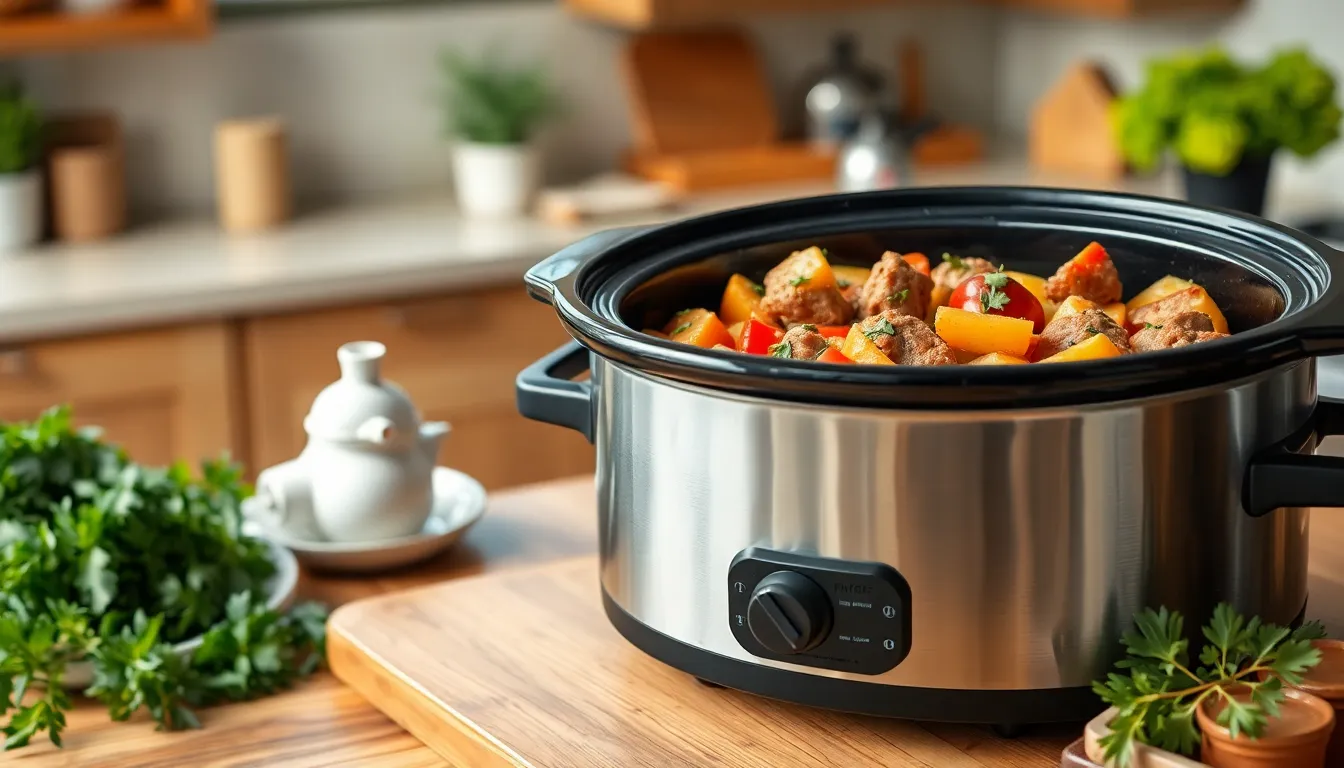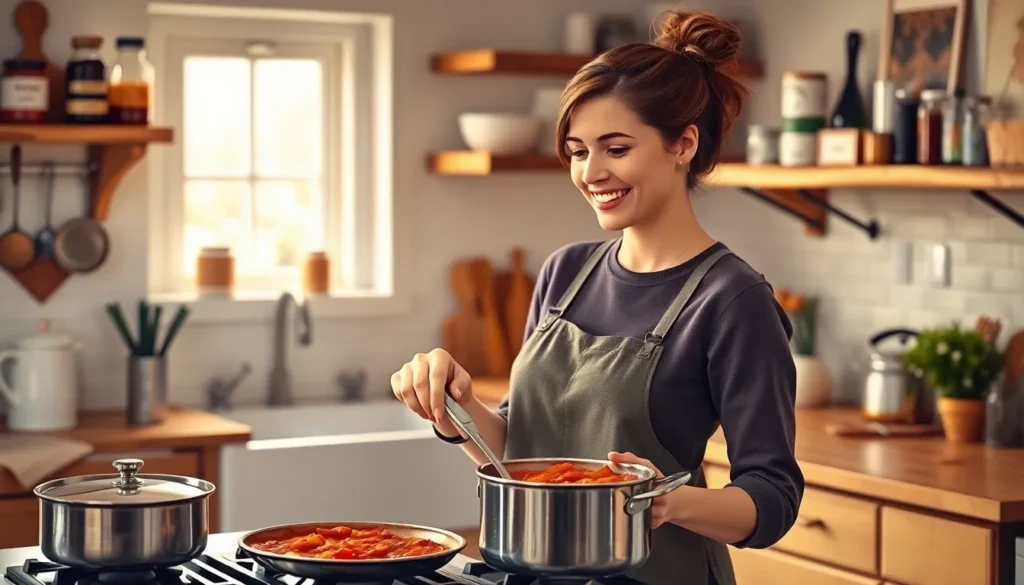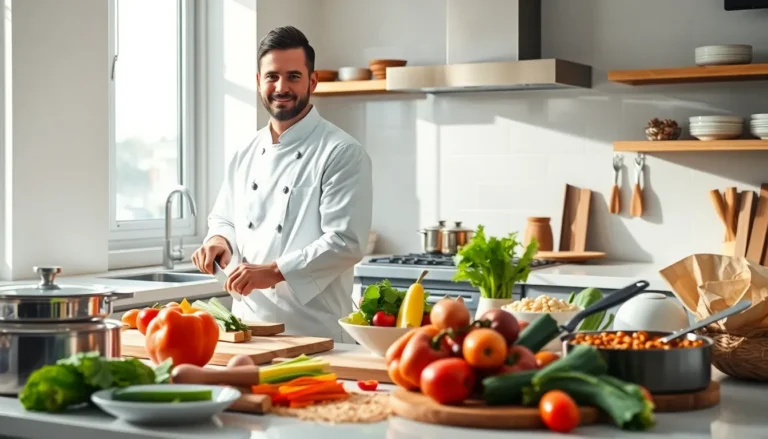Table of Contents
ToggleIn a world that glorifies speed and instant gratification, slow cooking stands as a delicious rebel. It’s like the tortoise in the fable, reminding everyone that good things really do come to those who wait. Imagine walking into your kitchen after a long day to the heavenly aroma of a meal that’s been simmering away, transforming simple ingredients into culinary magic.
Slow cooking isn’t just about convenience; it’s an art form that celebrates flavor and tenderness. Whether it’s a hearty stew or a melt-in-your-mouth roast, this method allows time to work its wonders. Plus, who wouldn’t want to set it and forget it while binge-watching their favorite show? With a slow cooker, dinner practically makes itself, leaving more time for the important things in life—like perfecting that couch potato pose. Dive into the world of slow cooking and discover how it can elevate weeknight dinners from mundane to mouthwatering.
What Is Slow Cooking?
Slow cooking refers to a culinary method that involves low heat and extended cooking times. This approach allows flavors to develop and intensify, resulting in rich and satisfying meals. Typically, a slow cooker, also known as a crockpot, is used, but the technique can be applied using traditional stovetops or ovens.
Key characteristics of slow cooking include its convenience and ability to enhance the tenderness of various food items. Meat, vegetables, and grains benefit significantly from this process. By cooking over several hours, tough cuts of meat transform into tender morsels full of flavor. Additionally, slow cooking requires minimal supervision, freeing up time for other tasks.
Specific benefits of slow cooking include improved retention of nutrients and enhanced flavor profiles. As ingredients meld together, the dish achieves a depth that quick cooking methods often miss. This technique particularly shines for stew recipes, bean dishes, and hearty soups.
Various recipes highlight the versatility of slow cooking. From savory chili to sweet desserts, the possibilities are endless. Ingredients can be prepared in advance; simply add them to the slow cooker, set the heat, and let it work its magic.
Ultimately, slow cooking turns meal preparation into a joyful, hands-off experience, making it a favored method for busy households. Embracing this style can elevate ordinary meals into culinary delights.
Benefits of Slow Cooking

Slow cooking offers numerous advantages that enhance both health and culinary experiences. This cooking method stands out not only for convenience but also for the flavors and nutrients it preserves.
Health Benefits
Nutrient retention features prominently in slow cooking. Cooking at lower temperatures allows ingredients to maintain vitamins and minerals, promoting healthier meals. The method also encourages the use of whole foods, such as vegetables and legumes, which contribute to a balanced diet. Slow cooking reduces the need for excessive oils or fats, making meals lighter and more nutritious. Additionally, simmering tough cuts of meat breaks down collagen, resulting in tender, digestible protein.
Culinary Benefits
Flavor enhancement plays a significant role in the appeal of slow cooking. Ingredients blend together over time, creating complex, layered tastes that elevate home-cooked dishes. Slow cooking also transforms inexpensive cuts of meat into savory meals, offering budget-friendly options for families. The method’s versatility allows for diverse recipes, from hearty soups to delectable desserts. Engaging all senses, the enticing aromas wafting through a home while cooking heighten anticipation and appreciation for meals.
Choosing the Right Slow Cooker
Selecting a slow cooker involves understanding the various types and essential features that enhance the cooking experience.
Types of Slow Cookers
Electric slow cookers are the most popular choice, featuring programmable settings for convenience. Stovetop models offer versatility, allowing for browning ingredients before slow cooking. Multi-cookers combine slow cooking with other functions like pressure cooking or sautéing. Others include manual versions that operate without electricity, appealing to those preferring simplicity. Size matters significantly; 4 to 6 quarts suits families, while larger models accommodate meal prep for gatherings.
Features to Consider
Temperature settings play a crucial role; options typically include low, high, and sometimes warm. Look for models with timers that allow for delayed start, ensuring meals are ready at specified times. A removable insert simplifies cleaning; materials like ceramic or non-stick enhance durability. Lids with tight seals help lock in flavors and moisture during cooking. Additional features like programmable controls or built-in sensors can elevate slow cooking experiences, offering precision and convenience.
Slow Cooking Techniques
Slow cooking offers diverse techniques that enhance flavor and convenience. Understanding these methods can lead to delightful culinary results.
Preparation Tips
Choose fresh, high-quality ingredients for the best outcome. Thaw frozen meats before cooking to ensure even heat distribution. Chop vegetables uniformly to promote consistent cooking. Layer sturdy ingredients at the bottom and delicate ones on top within the slow cooker. Season the dish early, allowing flavors to meld throughout the cooking process. Avoid filling the slow cooker to the brim; aim for about two-thirds full for optimal airflow. Lastly, don’t frequently lift the lid during cooking, as this releases heat and prolongs cooking time.
Cooking Times and Temperatures
Use low heat for longer cooking times, typically between 8 to 10 hours. High heat cooking usually lasts 4 to 6 hours and is ideal for quicker meal preparation. Certain ingredients like beans and grains require extended cooking times for proper tenderness. Meat should reach an internal temperature of at least 145°F for safety, but tougher cuts benefit from prolonged cooking to achieve optimal tenderness. Variations exist among different slow cooker models, so consult the manufacturer’s guide for temperature settings. Adjust cooking times based on specific recipes and personal preference.
Popular Slow Cooking Recipes
Slow cooking accommodates various tastes and preferences. It offers a range of recipes from comfort foods to quick meals.
Comfort Foods
Hearty stews embody the essence of comfort food, enhancing chilly evenings with warmth and flavor. Classic beef stew combines tender meat, hearty vegetables, and aromatic spices, all simmered to perfection. Another favorite, chicken and dumplings, marries tender chicken with fluffy dumplings, delivering satisfying textures. Vegetarian chili packs beans, peppers, and tomatoes into a single dish, offering warmth and nourishment. Slow-cooked macaroni and cheese provides creamy deliciousness, enchanting both kids and adults alike. Each of these recipes showcases how slow cooking creates rich flavors that comforts appetite.
Quick Meals
Incorporating slow cooking into the weeknight routine simplifies meal preparation. Recipes like pulled pork require minimal hands-on time while offering savory flavors. Tacos can be prepared by combining meat and spices in the slow cooker, allowing for easy assembly later. Another easy option is soup, where ingredients meld together to create delicious, warming bowls. Barbecue chicken becomes a treat when slow-cooked, yielding juicy, flavorful results perfect for sandwiches. The convenience of these quick meals means families spend less time in the kitchen and more time enjoying their time together.
Slow cooking stands out as a practical and rewarding approach to meal preparation. It not only saves time but also enriches the cooking experience. The ability to transform simple ingredients into mouthwatering dishes while enhancing flavors is a significant advantage.
With the right slow cooker and techniques, anyone can create nutritious and satisfying meals that cater to various tastes. Embracing this method allows for more quality time with family and friends while savoring the delightful aromas that fill the home.
For those seeking convenience without sacrificing flavor, slow cooking is the perfect solution. It’s time to explore the joys of this culinary art and elevate everyday meals into extraordinary experiences.



